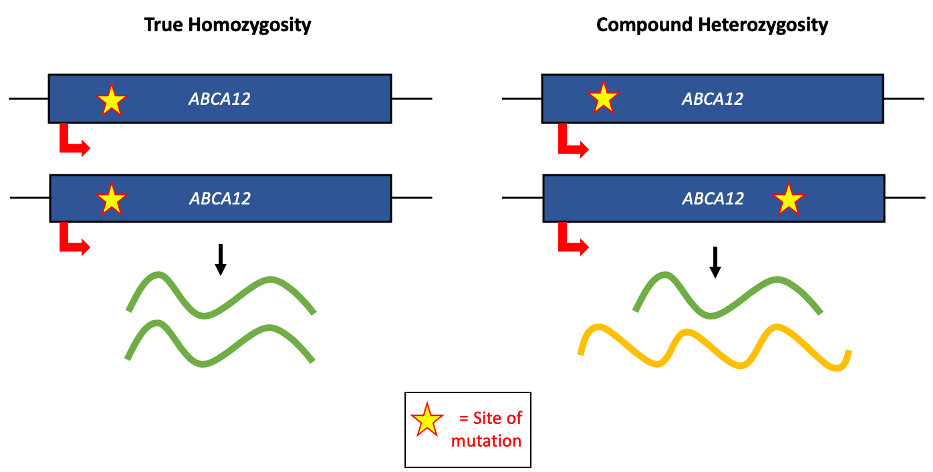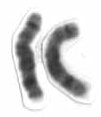|
Genodermatoses
Genodermatosis is a hereditary skin disease with three inherited modes including single gene inheritance, multiple gene inheritance and chromosome inheritance. There are many different types of genodermatosis, the prevalence of genodermatosis ranges from 1 per 6000 people to 1 per 500,000 people.Fields, D. (2019, June). Types of Genodermatoses. Retrieved September 08, 2020, from https://www.news-medical.net/health/Types-of-Genodermatoses.aspx Genodermatosis has influence on the texture, color and structure of skin cuticle and connective tissue, specific lesion site and clinical manifestations on the body vary depending on the type. In the spite of the variety and complexity of genodermatosis, there are still some common methods that can help people diagnose. After diagnosis, different types of genodermatosis require different levels of therapy including interventions, nursing interventions and treatments.Fondation René Touraine. (n.d.). Genodermatoses & Rare Skin Disorders - a publ ... [...More Info...] [...Related Items...] OR: [Wikipedia] [Google] [Baidu] |
Ichthyosis (2)
Ichthyosis is a family of genetic disorder, genetic skin disorders characterized by dry, thickened, scaly skin. The more than 20 types of ichthyosis range in severity of symptoms, outward appearance, underlying genetic cause and mode of inheritance (e.g., Dominance (genetics), dominant, recessive, autosomal or X-linked). Ichthyosis comes from the Greek language, Greek ἰχθύς ''ichthys'', literally "fish", since dry, scaly skin is the defining feature of all forms of ichthyosis. The severity of symptoms can vary enormously, from the mildest, most common, types such as ichthyosis vulgaris, which may be mistaken for normal dry skin, up to life-threatening conditions such as harlequin-type ichthyosis. Ichthyosis vulgaris accounts for more than 95% of cases. Types Many types of ichthyoses exist, and an exact diagnosis may be difficult. Types of ichthyoses are classified by their appearance, if they are syndromic or not, and by mode of inheritance. For example, non-syndromic ichthy ... [...More Info...] [...Related Items...] OR: [Wikipedia] [Google] [Baidu] |
Focal Dermal Hypoplasia
Focal dermal hypoplasia is a form of ectodermal dysplasia. It is a multisystem disorder characterized primarily by skin manifestations to the atrophic and hypoplastic areas of skin which are present at birth. These defects manifest as yellow-pink bumps on the skin and pigmentation changes. The disorder is also associated with shortness of stature and some evidence suggests that it can cause epilepsy. Genetics Focal dermal hypoplasia has been associated with PORCN gene mutations on the X chromosome. 90% of the individuals who are affected with the syndrome are female: the commonly accepted, though unconfirmed, explanation for this is that the non-mosaic hemizygous males are not viable. The differential diagnosis of focal dermal hypoplasia (Goltz) syndrome includes autosomal recessive Setleis syndrome due to TWIST2 gene mutations. It associated with morning glory anomaly, polymicrogyria, incontinentia pigmenti, oculocerebrocutaneous syndrome, Rothmund-Thomson syndrome and micro ... [...More Info...] [...Related Items...] OR: [Wikipedia] [Google] [Baidu] |
Ichthyosis Vulgaris
Ichthyosis vulgaris (also known as "autosomal dominant ichthyosis" and "Ichthyosis simplex") is a skin disorder causing dry, scaly skin. It is the most common form of ichthyosis,Freedberg, et al. (2003). ''Fitzpatrick's Dermatology in General Medicine''. (6th ed.). McGraw-Hill. . affecting around 1 in 250 people. For this reason it is known as common ichthyosis. It is usually an autosomal dominant inherited disease (often associated with filaggrin), although a rare non-heritable version called acquired ichthyosis exists.James, William; Berger, Timothy; Elston, Dirk (2005). ''Andrews' Diseases of the Skin: Clinical Dermatology''. (10th ed.). Saunders. . Presentation The symptoms of the inherited form of ichthyosis vulgaris are not usually present at birth but generally develop between three months and five years of age.''Ichthyo ... [...More Info...] [...Related Items...] OR: [Wikipedia] [Google] [Baidu] |
Harlequin-type Ichthyosis
Harlequin-type ichthyosis is a genetic disorder that results in thickened skin over nearly the entire body at birth. The skin forms large, diamond/trapezoid/rectangle-shaped plates that are separated by deep cracks. These affect the shape of the eyelids, nose, mouth, and ears and limit movement of the arms and legs. Restricted movement of the chest can lead to breathing difficulties. These plates fall off over several weeks. Other complications can include premature birth, infection, problems with body temperature, and dehydration. The condition is the most severe form of ichthyosis, a group of genetic disorders characterised by scaly skin. Harlequin-type ichthyosis is caused by mutations in the ''ABCA12'' gene. This gene codes for a protein necessary for transporting lipids out of cells in the outermost layer of skin. The disorder is autosomal recessive and inherited from parents who are carriers. Diagnosis is often based on appearance at birth and confirmed by genetic testin ... [...More Info...] [...Related Items...] OR: [Wikipedia] [Google] [Baidu] |
Epidermolysis Bullosa Dystrophica
Epidermolysis bullosa dystrophica or dystrophic EB (DEB) is an inherited disease affecting the skin and other organs. "Butterfly child" is the colloquial name for a child born with the disease, as their skin is seen to be as delicate and fragile as the wings of a butterfly. Signs and symptoms The deficiency in anchoring fibrils impairs the adherence between the epidermis and the underlying dermis. The skin of DEB patients is thus highly susceptible to severe blistering. Collagen VII is also associated with the epithelium of the esophageal lining, and DEB patients may have chronic scarring, webbing, and obstruction of the esophagus. Affected individuals are often severely malnourished due to trauma to the oral and esophageal mucosa and require feeding tubes for nutrition. They also have iron-deficiency anemia of uncertain origin, which leads to chronic fatigue. Open wounds on the skin heal slowly or not at all, often scarring extensively, and are particularly susceptible to infect ... [...More Info...] [...Related Items...] OR: [Wikipedia] [Google] [Baidu] |
Dyskeratosis Congenita
Dyskeratosis congenita (DKC), also known as Zinsser-Engman-Cole syndrome, is a rare progressive congenital disorder with a highly variable phenotype. The entity was classically defined by the triad of abnormal skin pigmentation, nail dystrophy, and leukoplakia of the oral mucosa, but these components do not always occur. DKC is characterized by short telomeres. Some of the manifestations resemble premature ageing (similar to progeria). The disease initially mainly affects the skin, but a major consequence is progressive bone marrow failure which occurs in over 80%, causing early mortality. Presentation DKC can be characterized by cutaneous pigmentation, premature graying, dystrophy of the nails, leukoplakia of the oral mucosa, continuous lacrimation due to atresia of the lacrimal ducts, often thrombocytopenia, anemia, testicular atrophy in the male carriers, and predisposition to cancer. Many of these symptoms are characteristic of geriatrics, and those carrying the more seriou ... [...More Info...] [...Related Items...] OR: [Wikipedia] [Google] [Baidu] |
Hypohidrotic Ectodermal Dysplasia
Hypohidrotic ectodermal dysplasia is one of about 150 types of ectodermal dysplasia in humans. Before birth, these disorders result in the abnormal development of structures including the skin, hair, nails, teeth, and sweat glands.Freedberg, et al. (2003). ''Fitzpatrick's Dermatology in General Medicine''. (6th ed.). McGraw-Hill. . Presentation Most people with hypohidrotic ectodermal dysplasia have a reduced ability to sweat (hypohidrosis) because they have fewer sweat glands than normal or their sweat glands do not function properly. Sweating is a major way that the body controls its temperature; as sweat evaporates from the skin, it cools the body. An inability to sweat can lead to a dangerously high body temperature (hyperthermia) particularly in hot weather. In some cases, hyperthermia can cause life-threatening medical problems. Affected individuals tend to have sparse scalp and body hair (hypotrichosis). The hair is often light-coloured, brittle, and slow-growing. This c ... [...More Info...] [...Related Items...] OR: [Wikipedia] [Google] [Baidu] |
Junctional Epidermolysis Bullosa (medicine)
Junctional epidermolysis bullosa is a skin condition characterized by blister formation within the lamina lucida of the basement membrane zone. Signs and symptoms People with the condition experience very fragile skin, with blisters and skin erosion occurring in response to relatively benign trauma. Blisters may form all over the body, including the mucous membranes. Chronic scarring can lead to the formation of granulation tissue, which may bleed easily, predisposing to infection. Hands and fingers may be affected, as well as various joints. Pathophysiology α6β4 integrin is a transmembrane protein found in hemidesmosomes. As a heterodimer molecule containing two polypeptide chains its extracellular domain enters the basal lamina and interacts with type IV collagen suprastructure containing laminins (laminin-5), entactin/nidongen or the perlecan. on the extracellular surface of the hemidesmosome, laminin-5 molecules form threadlike anchoring filaments that extend from the int ... [...More Info...] [...Related Items...] OR: [Wikipedia] [Google] [Baidu] |
Kindler Syndrome
Kindler syndrome (also known as "bullous acrokeratotic poikiloderma of Kindler and Weary",) is a rare congenital disease of the skin caused by a mutation in the KIND1 gene. Symptoms and signs Infants and young children with Kindler syndrome have a tendency to blister with minor trauma and are prone to sunburns. As individuals with Kindler syndrome age, they tend to have fewer problems with blistering and photosensitivity. However, pigment changes and thinning of the skin become more prominent. Kindler syndrome can affect various mucous tissues such as the mouth and eyes, which can lead to other health problems. Genetics Kindler syndrome is an autosomal recessive genodermatosis. The KIND1 gene mutated in Kindler syndrome codes for the protein kindlin-1, which is thought to be active in the interactions between actin and the extracellular matrix (focal adhesion plaques). Kindler syndrome was first described in 1954 by Theresa Kindler. Diagnosis Clinical and genetic tests are ... [...More Info...] [...Related Items...] OR: [Wikipedia] [Google] [Baidu] |
Acrodermatitis Enteropathica
Acrodermatitis enteropathica is an autosomal recessive metabolic disorder affecting the uptake of zinc through the inner lining of the bowel, the mucous membrane. It is characterized by inflammation of the skin (dermatitis) around bodily openings (periorificial) and the tips of fingers and toes (acral), hair loss (alopecia), and diarrhea. It can also be related to deficiency of zinc due to other, i.e. congenital causes. Other names for ''acrodermatitis enteropathica'' include Brandt syndrome and Danbolt–Cross syndrome. Signs and symptoms Individuals with acrodermatitis enteropathica may present with the following: * Blistering of skin * Dry skin * Emotional lability * Glossitis * Pustule Alopecia (loss of hair from the scalp, eyebrows, and eyelashes) may occur. Skin lesions may be secondarily infected by bacteria such as ''Staphylococcus aureus'' or fungi such as ''Candida albicans''. These skin lesions are accompanied by diarrhea. Genetics Acrodermatitis enteropathica, in te ... [...More Info...] [...Related Items...] OR: [Wikipedia] [Google] [Baidu] |
Xeroderma Pigmentosum
Xeroderma pigmentosum (XP) is a genetic disorder in which there is a decreased ability to repair DNA damage such as that caused by ultraviolet (UV) light. Symptoms may include a severe sunburn after only a few minutes in the sun, freckling in sun-exposed areas, dry skin and changes in skin pigmentation. Nervous system problems, such as hearing loss, poor coordination, loss of intellectual function and seizures, may also occur. Complications include a high risk of skin cancer, with about half having skin cancer by age 10 without preventative efforts, and cataracts. There may be a higher risk of other cancers such as brain cancers. XP is autosomal recessive, with mutations in at least nine specific genes able to result in the condition. Normally, the damage to DNA which occurs in skin cells from exposure to UV light is repaired by nucleotide excision repair. In people with xeroderma pigmentosum, this damage is not repaired. As more abnormalities form in DNA, cells malfunction and e ... [...More Info...] [...Related Items...] OR: [Wikipedia] [Google] [Baidu] |
Epidermolysis Bullosa
Epidermolysis bullosa (EB) is a group of rare medical conditions that result in easy blistering of the skin and mucous membranes. Blisters occur with minor trauma or friction and are painful. Its severity can range from mild to fatal. Inherited EB is a rare disease with a prevalence in the United States of 8.2 per million live births. Those with mild cases may not develop symptoms until they start to crawl or walk. Complications may include esophageal narrowing, squamous cell skin cancer, and the need for amputations. EB is due to a mutation in at least one of 16 different genes. Some types are autosomal dominant while others are autosomal recessive. The underlying mechanism is a defect in attachment between or within the layers of the skin. Loss or diminished function of C7 leads to weakness in the structural architecture of the dermal–epidermal junction (DEJ) and mucosal membranes. There are four main types: epidermolysis bullosa simplex (EBS), dystrophic epidermolysis bul ... [...More Info...] [...Related Items...] OR: [Wikipedia] [Google] [Baidu] |
.jpg)






